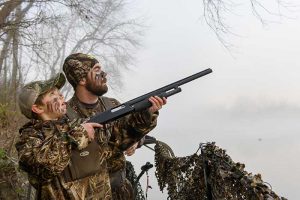Preparing Your Child for Their First Deer Hunt: A Comprehensive Guide

By Derrick R. Stallings – HuntingOfficer.com
Introducing your child to the sport of deer hunting is a special moment, one that can create lifelong memories and a deep appreciation for the outdoors. However, it’s important to ensure that your child is both physically and mentally prepared for this experience. Here’s a detailed guide to help you prepare your child for their first deer hunt:
1. Age and Maturity:
- Physical Readiness: Ensure your child is physically capable of handling the equipment and sitting still for extended periods.
- Mental Readiness: Assess their understanding of hunting ethics, respect for wildlife, and the importance of safety.
2. Hunter Education Course:
- Mandatory: Most states require hunters to complete a hunter education course. Enroll your child in a course that covers firearm safety, wildlife conservation, hunting laws, and ethical hunting practices.
- Hands-on Training: Look for courses that offer practical shooting exercises to reinforce safety and accuracy.
3. Choose the Right Firearm:
- Youth-Sized Firearm: Select a firearm specifically designed for young hunters, with a shorter stock and lighter weight.
- Proper Fit: Ensure the firearm fits your child comfortably to promote proper shooting form and reduce recoil.
- Practice Regularly: Schedule regular practice sessions at a shooting range under your supervision.
4. Develop Marksmanship Skills:
- Start Slow: Begin with basic shooting fundamentals, such as stance, grip, and sight alignment.
- Progressive Practice: Gradually increase the distance and difficulty of targets to challenge your child.
- Focus on Accuracy: Emphasize the importance of taking accurate shots rather than simply firing as many rounds as possible.
5. Teach Deer Identification and Behavior:
- Learn the Signs: Teach your child to recognize deer tracks, droppings, and other signs of deer activity.
- Understand Deer Habits: Discuss deer feeding patterns, movement habits, and their response to different weather conditions.
- Respect Wildlife: Instill a respect for deer and other wildlife, emphasizing the importance of fair chase and ethical hunting practices.
6. Prepare for the Hunt:
- Clothing and Gear: Select appropriate hunting clothing that is both comfortable and camouflaged.
- Layering: Dress in layers to adjust to changing weather conditions.
- Scent Control: Use scent-eliminating products to minimize human odor.
- Comfortable Footwear: Invest in sturdy, waterproof boots to protect your child’s feet.
- Essential Gear: Pack a hunting knife, a flashlight, a first-aid kit, and plenty of snacks and water.
- Hunting License and Permits: Obtain all necessary hunting licenses and permits before the hunt.
7. Safety First:
- Constant Supervision: Never allow your child to handle a firearm without your direct supervision.
- Treat Every Gun as Loaded: Teach your child to always treat a firearm as if it were loaded, even if they know it’s not.
- Safe Gun Handling: Reinforce the four basic rules of firearm safety:
- Treat every firearm with respect.
- Always keep the firearm pointed in a safe direction.
- Keep your finger off the trigger until you’re ready to shoot.
- Be sure of your target and what’s beyond it.
- Emergency Preparedness: Develop a plan for handling emergencies, such as unexpected weather conditions or wildlife encounters.
8. The Hunt Itself:
- Patience and Persistence: Deer hunting often requires patience and persistence. Encourage your child to remain calm and focused.
- Minimize Movement: Teach your child to remain still and avoid sudden movements that may spook deer.
- Respect the Harvest: If your child harvests a deer, ensure they understand the importance of treating the animal with respect.
- Field Dressing: Teach your child the proper techniques for field dressing a deer, including skinning and quartering.
9. Post-Hunt Activities:
- Process the Meat: Involve your child in the process of processing the meat, from butchering to packaging.
- Share the Experience: Share stories and photos of the hunt with family and friends.
- Reflect on the Experience: Discuss what your child learned from the hunt and how they can improve for future hunts.
By following these guidelines and fostering a love for the outdoors, you can create a positive and memorable first deer hunting experience for your child. Remember, safety is paramount, and patience and perseverance are key to a successful hunt.
*AI Assisted In The Writing Of This Article
Discover more from HuntingOfficer
Subscribe to get the latest posts sent to your email.
